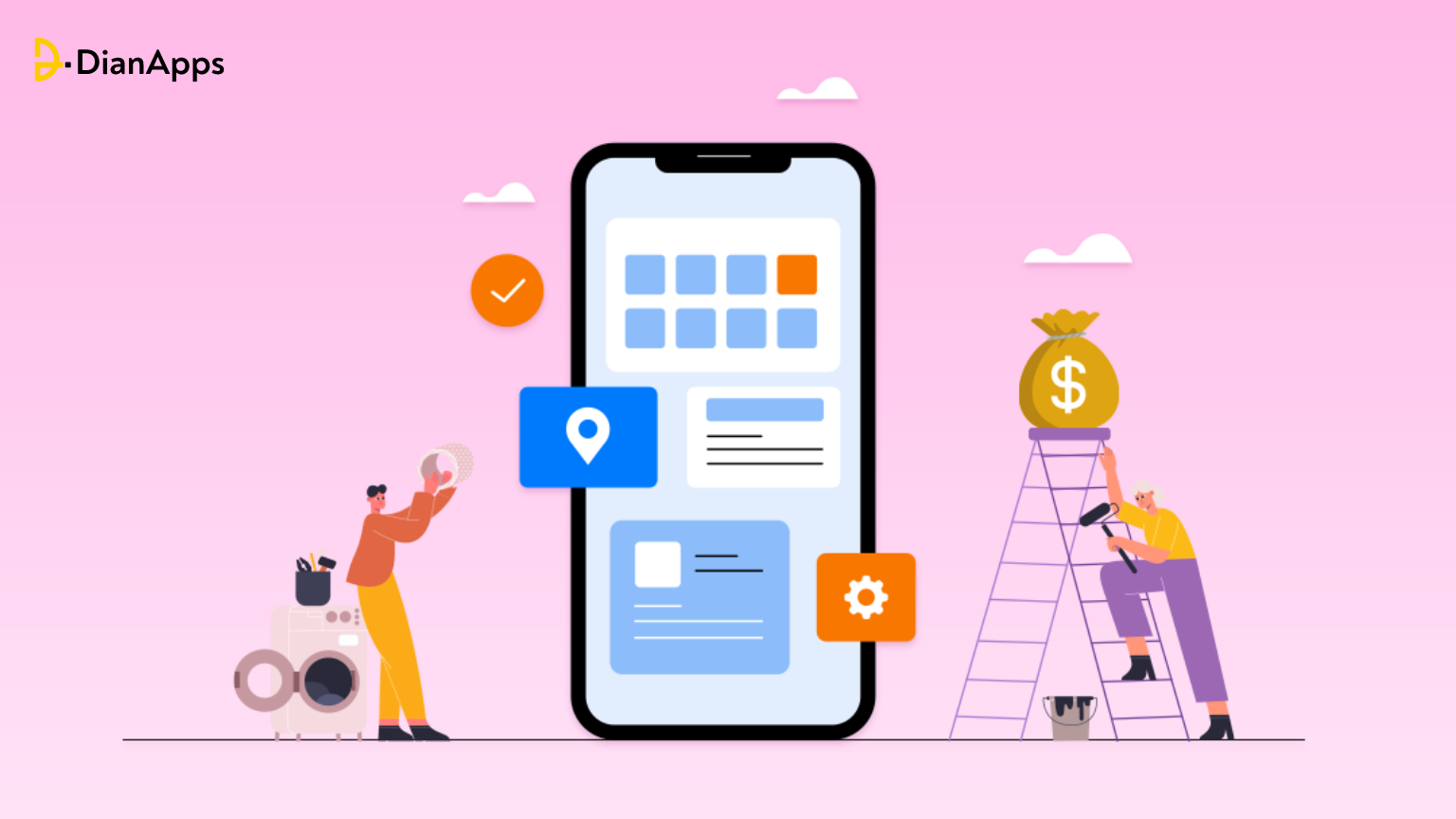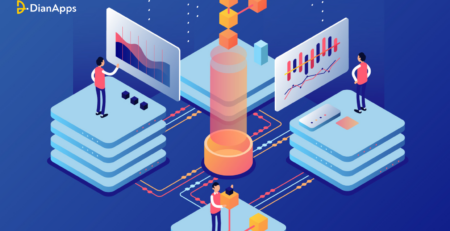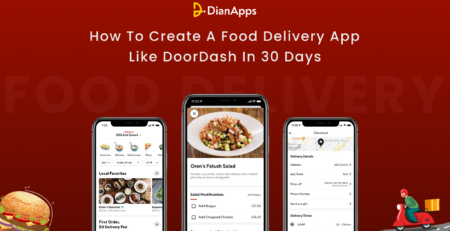How to Create an On-Demand App: a Complete Breakdown for Business Owners
What makes building an on-demand app promising? The on-demand market is growing and is expected to rise by $335 billion in 2025. As more and more ground-breaking on-demand apps will emerge more business owners search for methods to uberise new services.
So how can you make an on-demand software that becomes a client favorite and grows into a successful enterprise? We advise you to begin by reading this blog’s suggestions and best practices for developing on-demand apps.
Top Takeaways:
- If you want to create an app for on-demand services, keep in mind that you will be working on three different products: a web application for administrators and mobile applications for buyers and suppliers.
- You can find a detailed overview of the procedure in section 5, which is where you can learn how to create an on-demand app.
On-Demand Apps Market Statistics
On-demand applications to put simply is a fancy term for mobile app development services that enable users to order a product or service as per their preferences.
So instead of referring to apps like Amazon on-demand as mobile shopping solutions, why don’t we name them that? The problem with on-demand app development services is that they function as a marketplace that links vendors and consumers. Alright, so you can’t set up an Amazon seller account and start selling to people? Second of all, you still have to provide some assistance.
That’s right, creating an on-demand app is a smartphone marketplace that pairs merchants and customers with the option to add delivery or other services.
Look below the interesting statistics:
- By 2025, 42% of American adults will have used on-demand services at least once, and the on-demand market is expected to generate $335 billion in revenue.
- Throughout the pandemic, even the on-demand services most impacted by COVID continued to expand: Investors have invested about $14 billion in on-demand delivery services since the epidemic began, with 130 new ride-sharing businesses expected to launch in 2024.
- DoorDash reported revenues of $8.63 billion in 2023, a 31% increase on the previous year.
The following are the main sectors that on-demand mobile products benefit:
-
- Food delivery
- Transportation
- Home services
- Retail
- Professional services
- Healthcare
Type of On-Demand App Development
There are several kinds of on-demand applications available. Let’s examine the most captivating ones.
Initially, different publics may be the aim of on-demand applications:
- Business-to-business: Cargomatic, for instance, provides on-demand freight services.
- Business-to-consumer: Consider ride-sharing services like Uber.
- Customer-to-consumer: Airbnb is one example (vacation rentals)
Second, we may differentiate these applications based on the services they offer:
- Delivery of real products and services: Rover provides pet care, while Instacart delivers groceries
- Online consultations: On-demand physician
- Consumption of virtual content: Disney Plus
Finally, a business model allows us to distinguish between solutions:
- An on-demand app development solution that acts as an aggregator, linking consumers and sellers with various businesses
- Marketplace applications that function as a single point of contact for one business
On-Demand App Development Features That Businesses Must Know
A smartphone application for buyers, a different mobile application for suppliers, and a web gateway to administer both applications are required when you create an on-demand app. Let’s examine the characteristics your on-demand app needs to be completely functioning.
Buyer’s App Corner
Compared to an app for suppliers or a web portal, a mobile application for buyers often targets a larger audience and offers a greater feature set. The following are a few essential elements for the buyer solution:
- Enrollment and verification
- User header
- Wallet apps and payments
- Market for products and/or services
- Ordering and booking features
- Order Monitoring
- Evaluations and rankings
- Complementary and suggested AI tools
- Push or Local Notifications (depending on the requirement)
Furthermore, to create an on-demand app might profit from the following extra features:
- GPS and maps
- Rewards scheme
- Order history
- Favorites Chat
- Support
The precise features of the end-user application will vary depending on the kind of mobile app development services you intend to provide. For instance, a video chat feature is necessary for an on-demand medical app, and if you intend to rent scooters, the product may need to integrate with iBeacon to offer location-aware notifications.
Provider’s App Corner
What features should service providers include in their app to meet user demands as effectively as possible?
- User information
- Order processing
- Profits and daily updates
- Customer ratings
- Active or inactive
Some desirable attributes might be:
- Geolocation monitoring in real-time
- Online dialogue with clients
- Heat maps (which display the service’s current demand)
We recently shared the use of the Geolocation service in the React Native framework, would you like to give it a read?
In the past, provider mobile applications had a simple layout and sometimes limited features. But with more and more companies entering the market, you need to create an on-demand app with an excellent user experience (UX/UI design services) for providers. If not, they can decide on a business that provides more practical software. For instance, the navigation screen would be the most crucial one in the program for drivers or couriers.
Admin Web Portal
The final component is the administrator online interface, which allows your staff to administer both mobile applications and compile use data, among other things. What features are essential for this web application?
- Content moderation in apps
- Order management by hand
- Charges and Subscriptions
- Notification guidelines
- User blocking and unblocking
- Analytics and reports
To manage their users and contents, the buyer and supplier applications should be integrated with the admins’ web application. Additionally, you may monitor the performance of your product there in terms of services rendered, funds received, etc.
Positively, since the online solution doesn’t interact with clients, you don’t need to spend excessive amounts of money building it. That ought to be plenty as long as using the UI is simple.
Technology Stack Required To Build On-Demand Business App
On-demand mobile app development might initially appear to be much like any other mobile project. Additionally, the tech stack for mobile apps won’t be all that different from the technologies frequently employed in custom mobile app development.
Both native (Kotlin and Swift) and cross-platform (React Native or Flutter app development services) approaches can be used to essentially accomplish the same goal. Simultaneously, these quirks will significantly impact the technology you select:
- Machine learning skills (algorithms for matching)
- The requirement to handle large amounts of data
- The capacity to scale up swiftly
TensorFlow and Python will probably need to be used server-side for machine learning. Furthermore, you have to stay with the native tech stack (Kotlin/Java or Swift) if you want on-device machine learning capabilities.
Large-scale data sets generated by several clients must be processed, hence RabbitMQ and Apache Spark are required.
Cloud services like AWS or Google Cloud will take care of scaling up.
After that, you should consider the web technologies that will be used to create the admin portal. Anything akin to Laravel or a comparable framework, in my opinion, will function flawlessly in this situation. Firstly, since Laravel has built-in functionality like user role management and authorization. Furthermore, each component may be altered to meet your specific needs.
Steps To Build On-Demand Business Application in 2024
As previously said, developing apps for on-demand services entails developing many applications:
- A client-focused mobile solution
- A mobile offering for service companies
- An admin portal on the web
However, precisely how do you go about creating your own on-demand services application?
Step1: Fast prototyping
Like any other mobile solution, DianApps starts the on-demand app development process with a fast prototype. A quick prototype is what? Your product is only a graphical shell with no underlying programming. You thus create an on-demand service app as the initial stage.
To validate your idea and make the necessary adjustments to best meet the expectations of your consumers, we begin with a prototype. Test participants can navigate through a prototype’s displays directly on their mobile devices or via a browser.
You may refine the UI/UX design services further based on how well users engage with the prototype. The best feature is that you can keep your development budget within safe limits because no code needs to be created.
Expert Advice:
- By starting with a prototype, you may establish an agile development framework that will help you later on in the project’s overall development.
- Use the feedback from developers to improve the design of your program. Their advice should be focused on edge situations, animations, and whole new user interface interactions.
- To create an engaging user experience, take into account the demands of both buyers and sellers (a provider app needs to be as polished and thought out as the buyer’s)
Step2: Development Process
To create an on-demand service platform, the next stage involves adding code to the graphical application shell. Your software developers should be acquainted with the procedure. Here are some things to remember.
Backend:
Are you prepared for your next epiphany? Development of on-demand app development services requires not only the creation of three distinct applications but also the creation of their back ends.
Remember, when users engage with front ends (whether it is a mobile or online application), the majority of the logic and computations take place on the back end.
As a result, you will want two back ends: one for the admin web portal and another for end-user and provider apps. Think of the back end as the brains of your on-demand application. APIs are located there, enabling data syncing and communication among all the apps.
Another way your mobile product interfaces with other apps is through APIs. It is important to include consideration for this in the general back-end design if you believe that other developers will find value in building new products around your offering.
Code suitability:
Thankfully, it’s not necessary for you to completely create both mobile applications from the start. Certain code blocks can be reused to expedite development. That applies to the majority of generic components, such as user profiles, settings, login and registration, and other features that are comparable and shared by both applications.
Applying mobile sdcks:
Mobile SDKs are an additional strategy that aids in cost optimization when developing your on-demand software. Many off-the-shelf SDKs are available to speed up the development of various functionalities for your on-demand solution.
A few SDKs to get you going are as follows:
- Twilio and SendBird as a chat option
- (Aside from Apple’s MapKit and Google’s Maps SDK) MapBox and Here
- For payments, Stripe and Authorize.net
- UserVoice and Intercom for customer service
- One Signal and PushWoosh for alerts
- For audio and video calling, use Agora.io and Twilio.
- Your decision will ultimately depend on the things you wish to provide.
Offline mode:
Think about including offline app use support. This feature is certainly worth it even if it adds a whole new level of complexity. Your engineers must implement a caching mechanism in this stage so that any data entered while the application is offline is synchronized. Keep in mind that the offline and online versions of the app will also require distinct visual cues.
Technical learning:
The fact that on-demand applications are usually rather clever is one of the factors contributing to their rise in popularity. As customers interact with the product, they gather additional user data that helps them improve their matching and recommendation algorithms.
Note that this AI feature may be implemented directly on a mobile device or in the back end (cloud-based). If you want to learn more about this topic, we offer a blog specifically dedicated to ML app development. However, to give you an overview, on-device ML is said to be more secure and offers a flawless user experience, particularly when it comes to augmented reality and object detection.
Integration of Payments:
It is too difficult to build a digital wallet within an on-demand service. Integrating with a payment processing business like Stripe is a better method to enable payments in the early stages of your project. For instance, in the past, Uber utilized Braintree to process payments.
As you eventually reach a respectable number of transactions, you can interface directly with MasterCard/Visa or banks.
By the time you read this, Apple will let you promote other payment options, which is also worth mentioning. Therefore, you’ll be able to sign up new users without paying Apple’s charge when the time comes to launch subscription services.
Consideration during Web App Development:
The web portal is mostly used to manage content in mobile applications and collect different performance metrics. As a result, it makes sense to add a dashboard with reports and quick insights to the site.
Additionally, you want to restrict user roles’ access permissions to certain custom web app development portions. Moderators may then only view material created by users, and accounting data can only be shared with staff members in your finance department.
Expert Advice:
- First, if you don’t already have a development team, we suggest reading our post on how to find and hire app developers.
- To improve predictability and visibility into the development process, apply agile.
- To measure user engagement, integrate the mobile apps with Flurry or Google Analytics.
- Granular notification controls should be implemented to allow users to select which messages they wish to receive.
- Consider your on-demand app’s users a community and provide them with self-moderation tools.
- Make sure you thoroughly examine any SDKs you want to utilize for any limitations or requirements conflicts.
Step3: Quality Assurance & DevOps
Naturally, before publishing an on-demand service app, you have to make sure it runs without a hitch.
- Mechanical Tests
Manually testing an on-demand service app is a terrible idea when developing one. An on-demand application is a sophisticated solution that requires automated testing, which is best done with QA platforms like Sentry. Automated testing solutions assist you in continuously identifying problems and pointing your programmers in the appropriate route for resolution.
The use of specialist goods like Kobiton is another strategy for advancing mobile testing. Testing your mobile on-demand apps on actual devices running various OS versions seems to be the benefit. Envision delivering your application to a horde of robots outfitted with a variety of cell phones.
- Manual testing
That is not to argue that you can completely eschew manual testing. Automated testing does, however, aid in the quick identification of many problems. Your QA team will then find any last UX peculiarities and small bugs when they manually review the apps.
Ensure that your team runs each of these tests on the admin portal and your mobile applications:
- Tests of regression
- Tests of units
- Integration examinations
- Tests for smoke
- Functional examinations
What is DevOps?
Why did we include DevOps in the subtitle, then? What connection does it have to testing and development? DevOps services and solutions, to put it simply, are a collection of practices and instruments that optimize the development process.
Imagine it as a conveyor belt, with the development team entering code on one side and the QA team and other parties on the other.
Testers may always work with the most recent version of the application without interfering with developers once DevOps is in place. If new faults crop up in a new version, your development team may quickly revert to the earlier version thanks to DevOps.
Similarly, following the public release, developers will be able to easily provide updated versions to QA and submit validated apps to mobile stores thanks to DevOps tools.
Expert Advice:
- As soon as you start getting the initial versions of the app, begin testing.
- Regression testing is critical; it focuses on verifying that all earlier issues are still present in updated versions.
- Peer-to-peer code testing is a recommended development process.
- To make sure the server can handle a large number of active users, stress test it.
Step 4: Launch
Eventually, you’ll have a fully functional gold version of your online and mobile applications. At that point, you let it go.
It can appear to be an easy step. Honestly, shipping the apps to market just takes a few days. That is, however, only true if your development staff is highly skilled and fully conversant with Google Play and App Store regulations.
However, if you want to know the steps on how to upload an app to the App Store, here’s the blog you need to read now!
At this point, you must ensure that the mobile applications are in communication with the server-side production environment by uploading them to the appropriate mobile shops. As an aside, the apps frequently communicate data with a testing server environment as they are being developed.
Expert Advice:
- Before a worldwide release, make a last check with a small sample of users (using Google’s open testing options and TestFlight for iOS).
- Take extra care while reviewing your listings on the Google Play and App Store (use Appfigures to help you with that).
- Ensure that DevOps is configured; all upcoming changes must be carried out without a hitch.
Step5: Maintenance
As you are undoubtedly aware, you can’t sit back and take it easy once the software becomes successful. Be ready to track app performance, analyze user input, and plan for the next releases.
Users using strange gadgets will continue to report oddities and worst-case situations. You should be good, though, if you installed an app performance tracking tool as per my earlier suggestion. You’ll be able to identify and correct these mishaps with greater speed.
Subsequently, resources such as Google Analytics will offer more comprehension into users’ interactions with the program. It occasionally results in UX modifications. Assume that most users don’t finish the first startup instruction. You must now devise a more effective onboarding strategy.
How Much Will It Cost To Develop an On-Demand App for Business?
“What budget does it take to start an on-demand app?” is probably on your mind. A minimal viable product (MVP), a condensed version of all three applications with just enough functionality to attract users, will cost about $280,000 to develop.
You should budget more in the $500,000–$600,000 range for app development when it comes to a whole app—that is, three applications.
Our Experience in Developing On-Demand Applications
One of the most interesting on-demand applications we developed was Uber Eats, a smartphone app for food delivery services. We were brought in to improve the app’s prototype and advance it. Making the app compatible with a variety of technology tools and equipment to ensure the client’s app runs smoothly and performs effectively in all parts of California and other countries.
The majority of the on-demand applications we have developed center around a variety of business domains and industries. As a leading mobile app development company in the USA, we advise you to get in contact with our team to address any questions or want guidance on your project.




